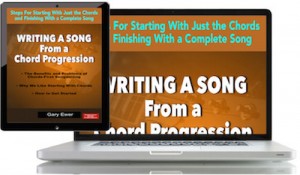Do you find frustration building practically every time you sit down to write a song? Sometimes you find that a song’s first ideas will come to you quickly, but what to do with those ideas… That’s when the frustration kicks in, and everything starts to feel hopeless.
One of the most common causes of songwriting frustration is that your goals are too large and all-encompassing. It’s a bit like wanting to become a mountain climber, so you fixate on climbing Mount Everest. The problem with that is… well, it’s Mount Everest!
 If you like starting songs by working out the chord progression first, you will love “Writing a Song From a Chord Progression.” It’s part of the 10-eBook “Essential Secrets of Songwriting” Bundle.
If you like starting songs by working out the chord progression first, you will love “Writing a Song From a Chord Progression.” It’s part of the 10-eBook “Essential Secrets of Songwriting” Bundle.
Trying to picture an entire song as you sit down to write is a bit like that. It can feel daunting to imagine that these first few ideas are eventually going to turn into a full song. That inability to picture it all turns to a kind of fear: a fear of failure. That fear has a way of growing and impeding your songwriting process, and before you know it, you’re stuck.
Setting Smaller Goals
The answer? Set smaller songwriting goals for yourself. Don’t assume that every songwriting session you undertake has to end with a completed song.
There are days when creativity seems difficult, and your musical imagination practically non-existent. It’s normal to feel that way from time to time. While it can be a solution to simply put your instrument away and do something else, there is another solution: stick with your songwriting, but set a smaller goal for that day.
And what could that smaller goal be? There are lots of possibilities, but here’s a short list to consider:
- Make a list of song topics/titles/ideas. Don’t try to worry about what those ideas might grow into. Just get some ideas going. Keep those ideas, because you’ll be able to make use of some of them in future songwriting projects.
- Make a list of first lines. This can be kind of fun, because you don’t feel the pressure to write a complete lyric, and you don’t even need to worry where the lines you create might go.
- Make a short, 3- or 4-chord progression, and experiment. Try different playing styles, different time signatures, different harmonic rhythm, etc. Imagine you’re starting a song with this progression. What can you do to these chords to entice the listener to keep listening?
- Write one song section. Rather than fixating on writing an entire song, just limit your work to one section of that song, and then put it away. Even if you feel like writing more, keep the task small, then take a break.
- Have fun with a book. Take a book, open it to a random page, point to a word, and then create a line of lyric that starts with that word. Then create a line of lyric that ends with the word. Flip to a new page, and do it again.
There’s lots you can do, and these are just 5 quick ideas. The point is that from time to time, you need to give yourself a break and not feel you have to write a complete song every time you sit down with your instrument.
The benefit of setting smaller goals is that it keeps you from feeling that you’re not getting anything done, and keeps writer’s block from developing. I feel that most developing songwriters should do this sort of thing 2 or 3 times every week at a minimum. You’ll love how relaxed it can make you feel.
 Written by Gary Ewer. Follow Gary on Twitter
Written by Gary Ewer. Follow Gary on Twitter
“How to Harmonize a Melody” is part of the 10-eBook Deluxe Bundle, written by Gary Ewer. If you can “hear” the chords you want, but you just can’t find them, this ebook will take you step-by-step through a process that works.
Right now get a FREE COPY of “Creative Chord Progressions” with your purchase of that bundle package.












Pingback: CREATIVITEIT | de gouden regel van kleine doelen stellen | Her Human Universe
Pingback: Mijn maand MEI | Her Human Universe
Pingback: The Power of Setting Small Songwriting Goals - The Hit Songwriting Formula | The Hit Songwriting Formula